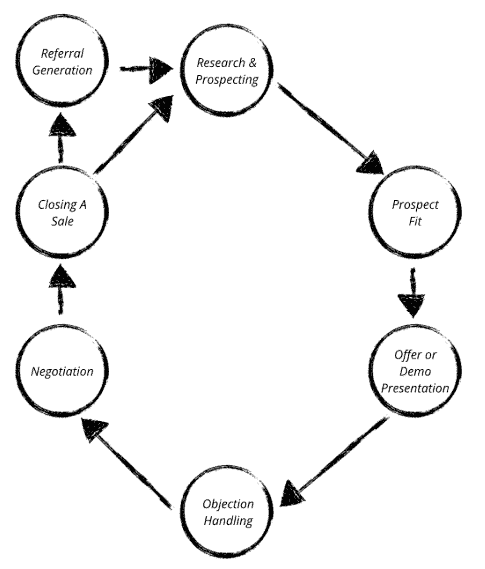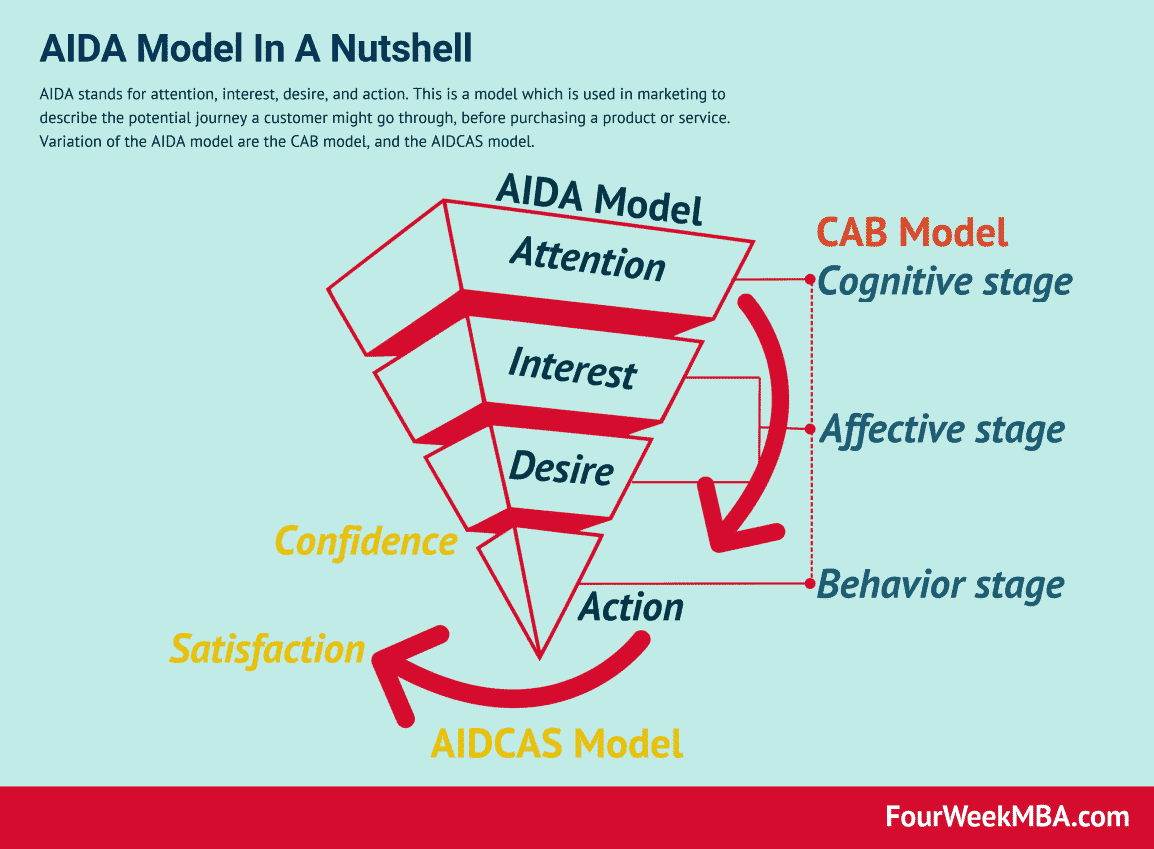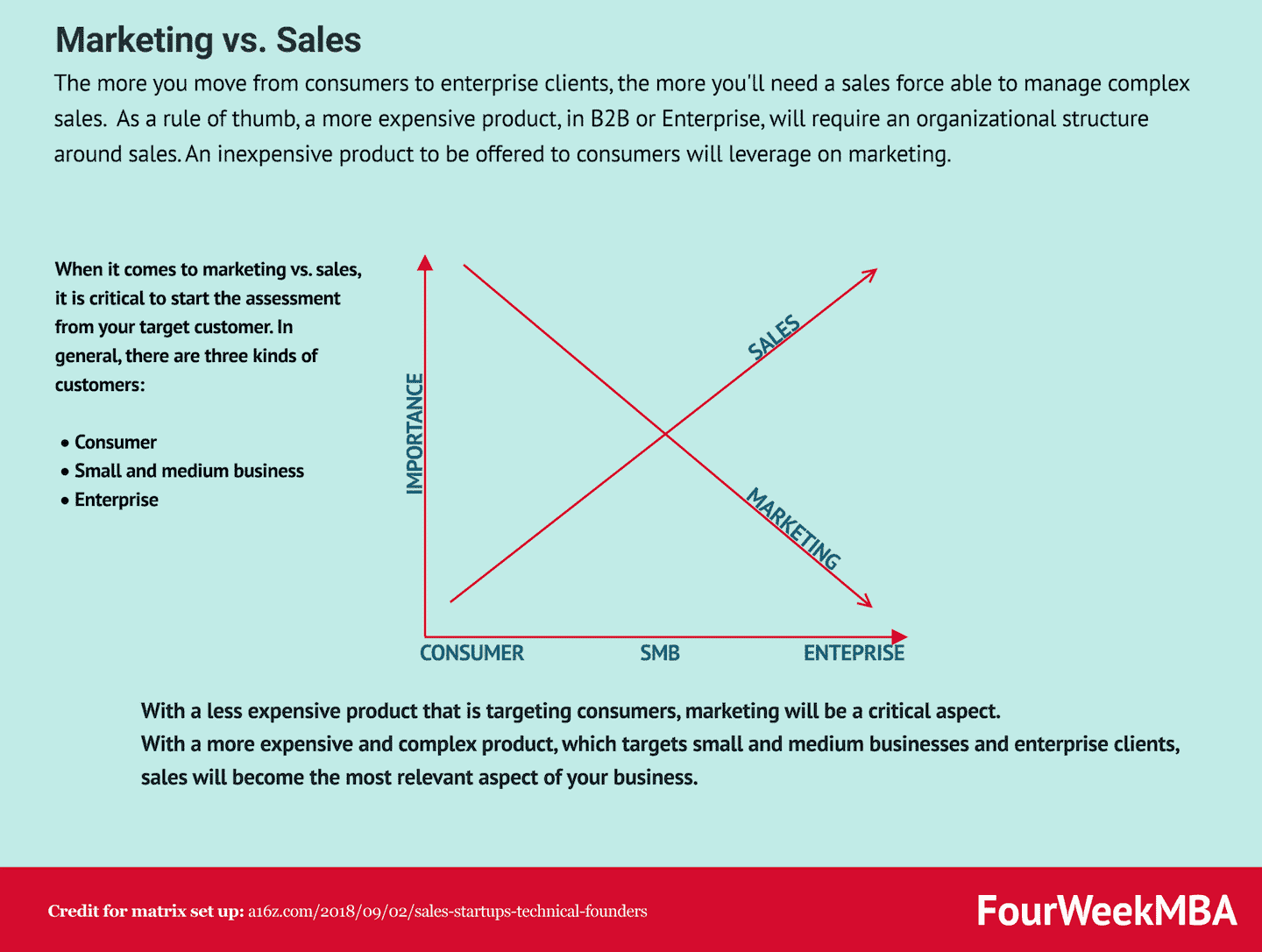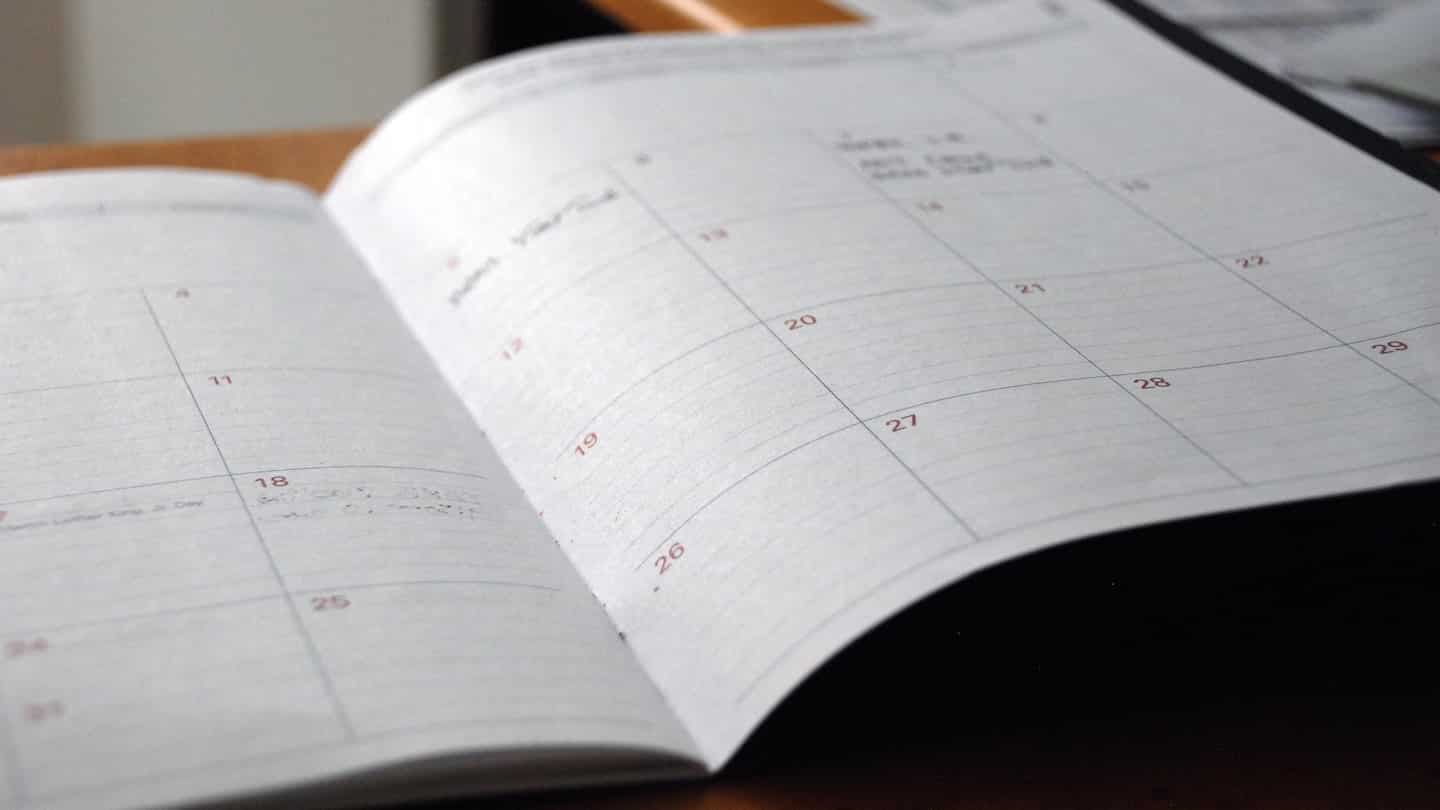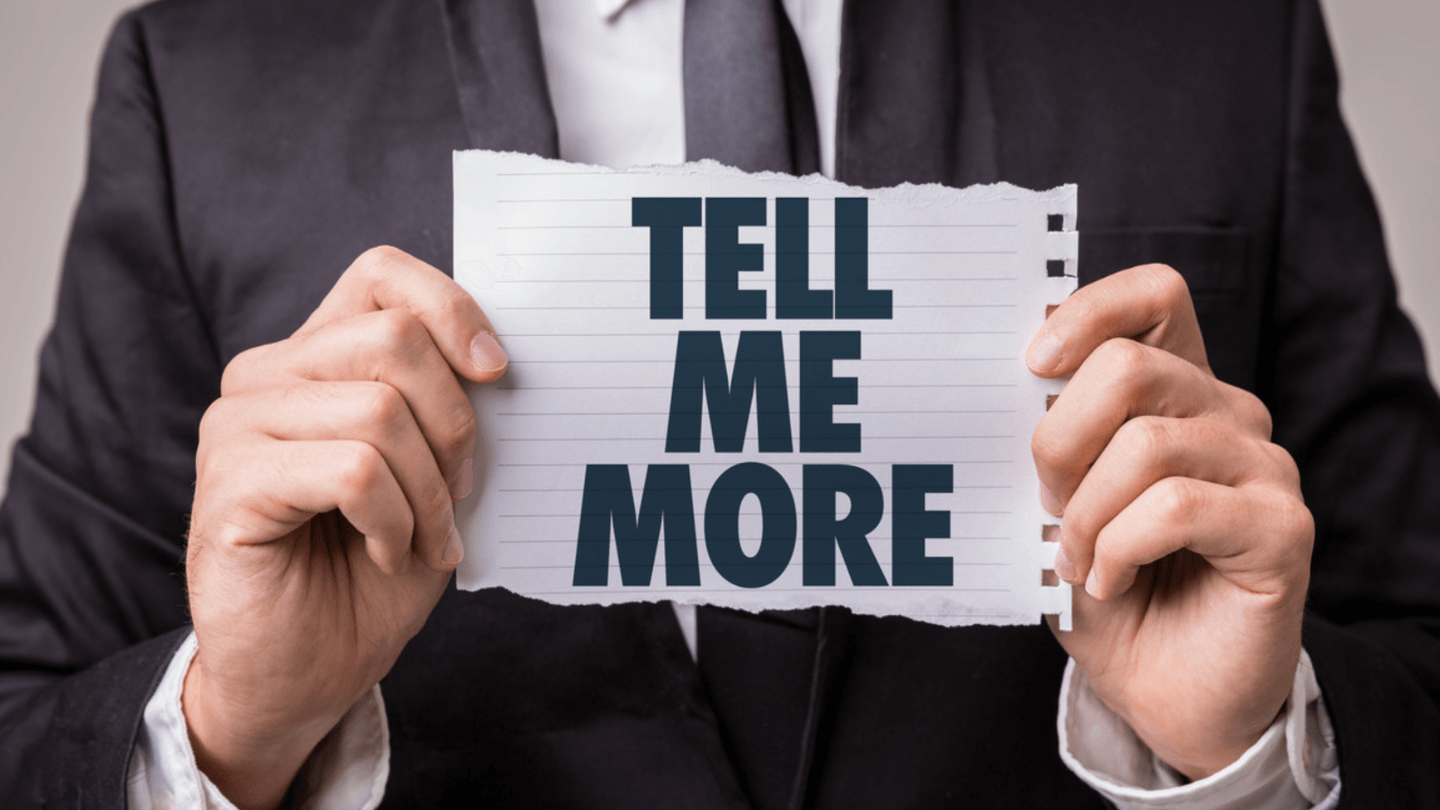To shorten the sales cycle, it is fundamental to have a good understanding of it and to align your whole team with what needs to be done. Being clear about the stages of your company’s (and your sector’s) sales cycle will enable you to improve it and be more efficient.
Sales activities should be process-oriented and very well planned. Implementing and repeatedly testing these processes helps your salespeople to improve their conversation rates. Creating sustainable growth is key to the long-term success of your business.
In this article, we offer you a short guide to the sales cycle and how to shorten it.
Sommaire
The 7 stages of the BtoB sales cycle
There’s no point in trying to shorten your sales cycle if you can’t define the steps precisely. To keep it simple, we explain the 7 main steps:
1. Making contact
In the first instance, you will make contact with your prospects, usually by telephone or e-mail. The aim is to introduce yourself and your company, but also to start a dialogue about the prospect’s needs. Be friendly and encouraging: you are trying to establish a relationship.
Going further
We won’t go into detail here about all the steps involved in prospecting, but we’ll refer you to all the articles we’ve written on the subject:
2. The discovery and qualification phase
To find out if a prospect is suitable for your product or service, try to find out as much as possible about their difficulties and identify their needs. Ask qualifying questions, research their business: you can develop a prospect scoring model (or take a BANT-type model) to assess their likelihood of becoming a customer.
Going further
3. The sales pitch
This is the time for your presentation: the idea is to have a tailored offer designed to meet the prospect’s specific needs. If the pitch goes well, this stage may also involve sending a proposal for review.
Going further
4. The objection phase
Expect your prospects to have concerns, questions or even objections about the offer. Whether it’s related to price, timing or the solution itself, this is an opportunity to listen and learn about their concerns.
5. Commercial negotiation
Objections should be seen as an opportunity to discover your prospect’s needs, and then reposition your offer to meet them.
Going further
6. Closing
Closing a deal is both an art and a science. Refine your closing techniques to get your prospect on board and turn them into a new customer.
7. Creating a sustainable business relationship
You have made your sale and the customer has signed, but the sales process is not over: it is essential to maintain the relationship of trust between you and your customer. To keep the customer loyal, think of the 4Rs technique: reassure, thank, take them home, see them again. Make sure they are satisfied, follow up to see if there is anything you can do to help them get the most out of your product or service. If they are completely satisfied, this is the perfect opportunity to ask them to recommend you or to retain them.
Going further
How to exploit the stages of the sale?
It is important to identify your sales stages early on by using or developing a model, especially of how potential customers get to know you.
In marketing, there is the famous AIDA model (Attention, Interest, Desire, Action) which highlights the four stages a prospect goes through before making a decision. This allows you to understand what stage a prospect is in, and then prioritise the steps to improve.
But if you really want to understand which steps to improve and how to prioritise them, you can use sales funnel models.
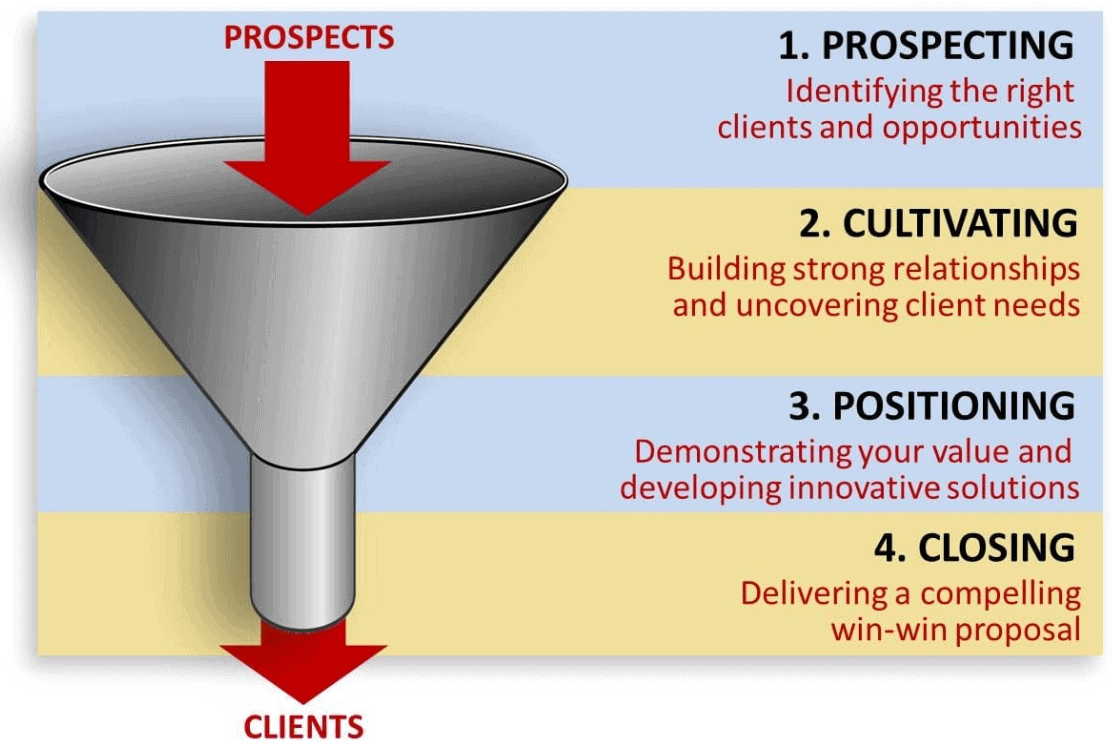
The sales funnel represents an ideal, potential pathway through which potential customers pass before becoming actual customers. As a representation, it is also often an approximation, helping marketing and sales teams to structure their processes on a large scale, allowing for repeatable sales and marketing tactics to convert customers.
But there are lots of different models, and you have to be careful not to impose a model on a company that doesn’t fit it at all. Just moving from B2C to B2B can change everything: as a rule of thumb, a more expensive product requires an organisational structure around the sales team, whereas a low-cost product aimed at individuals will rely on marketing.
For example, a more marketing-oriented company will tend to follow a flywheel model, where scale is more important than the quality of each prospect.
The same applies to freemium business models (so called when the whole organisation is aligned with the freemium offer), where the top of the funnel is occupied by a large number of prospects.
How to calculate and estimate the length of a sales cycle?
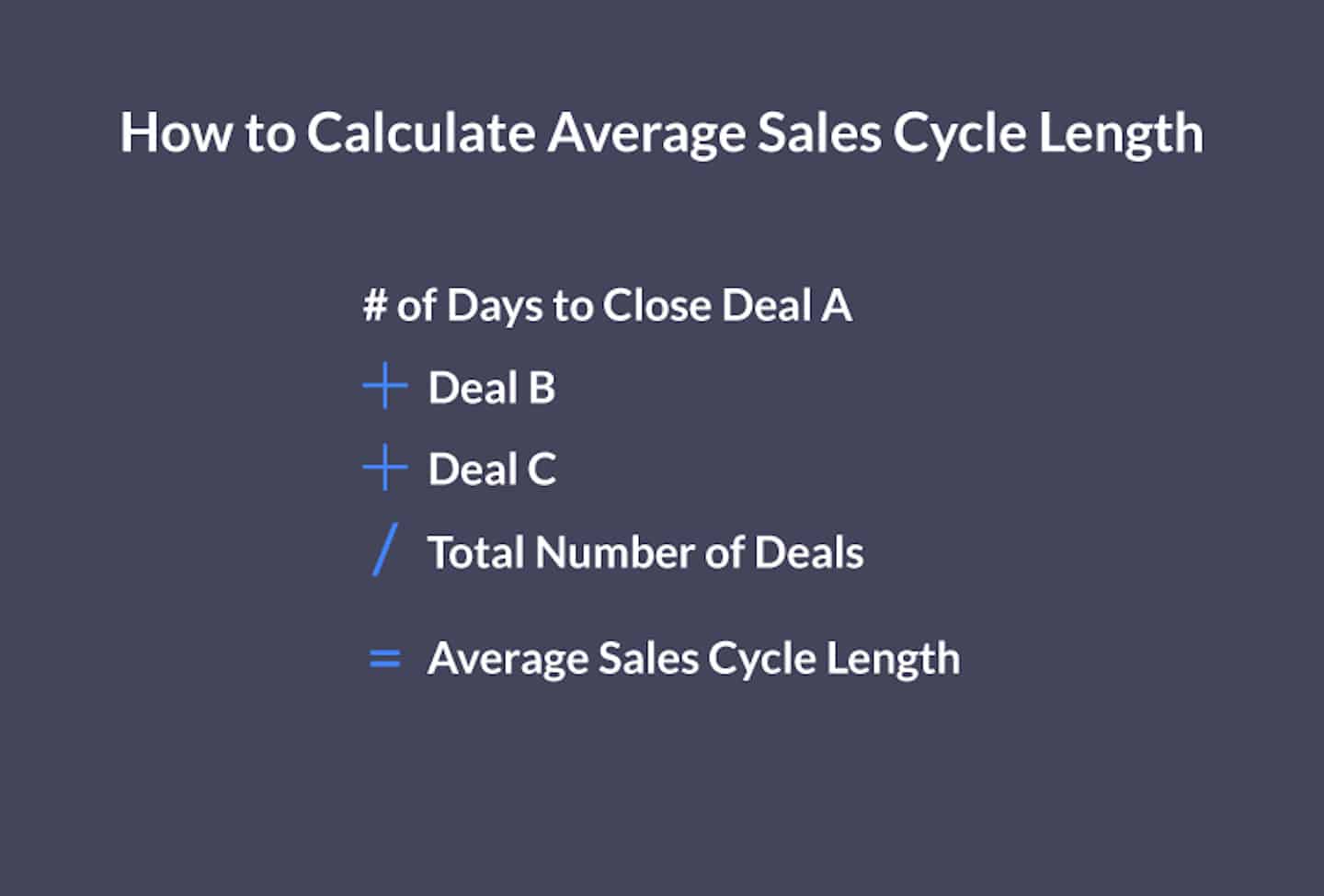
The length of your average sales cycle says a lot about your business, and tracking it carefully can provide valuable information for optimising your sales process.
For example, you find that certain types of customers get stuck at certain stages, which prolongs the sales cycle, making it more expensive. It’s all about reducing bottlenecks to speed up your whole sales process.
Method of calculating the length of the sales cycle
To estimate the length of the sales cycle, look at past sales data and calculate the average number of days between the start and the conclusion of the date.
The first step is to add up the total number of days it took to close each sale in the week, month, quarter or year you wish to measure. Then divide the sum by the total number of transactions.
For example, let’s say you recently closed three deals with the following sales cycle times:
- Deal A = 10 days
- Deal B = 14 days
- Deal C = 16 days
To find out your average sales cycle, simply add up the duration of each transaction to get a total of 40 days for all sales combined.
Then divide the number of days by the number of transactions to get the average duration in days.
40 / 3 = 13.3 days
With this indicator, you can estimate that similar transactions in the future will take about 13.3 days. This allows you to forecast future revenues and predict closing dates.
Attention
There is always a (significant) bias with averages. A good average should be the average of (relatively) homogeneous objects. So keep an eye on the standard deviation (the variance) of the dataset, even if it means segmenting into several sales cycles (if they are really very different) and measuring the duration for each.
If you get a roughly Gaussian (bell-shaped) distribution, you have a good chance of being in the ballpark. If you get two or more peaks, segment.
When should the sales cycle be started?
When it comes to measuring the length of your sales cycle, there are several schools of thought, including when the sales cycle actually begins.
Although it sounds simple, defining the starting point of your sales cycle is trickier than you might think. There are three moments that can signal its start:
- When a contact enters your CRM for the first time.
- When you first contact a new prospect.
- When a prospect becomes an opportunity.
Tracking your sales cycle from the moment a new lead is created in your CRM is known as first contact attribution. Those who use this method often focus on optimising top-of-channel activities, such as lead generation and prospecting.
On the other hand, starting your sales cycle when you first contact a new prospect excludes prospecting from the measure. It may be a better option if you buy lists of prospects and enter them into your CRM before contacting them (for example, if you need to do further research but want to keep their details in your system).
Finally, some companies prefer to start their sales cycle when a lead becomes an opportunity. This results in fewer steps in the sales cycle, which is beneficial for teams that want to focus on optimising the negotiation, closing and follow-up stages. However, this only works if your team has a clear understanding of the difference between leads and opportunities.
In brief
Whichever starting point you choose, make sure that your entire team is clear about which specific activity triggers the sales cycle. Constant monitoring is essential to calculate an accurate average time and identify how changes in the sales process can be used to shorten your sales cycle.
10 tips to speed up your sales cycles

1. Work on your targeting
If your sales pipeline starts to leak at the qualification stage, you may be attracting prospects who match your interests but are not the decision makers you need. It’s all about identifying the titles that cause the most difficulty in your conversation – perhaps it would be better to omit them from your research?
2. Review each step to identify blockages
The more you know about your prospects’ journey through the pipeline, the more likely you are to detect a problem before it’s too late. If you see a bottleneck developing, focus on the relevant stage of the sales cycle to find the cause of the blockage.
For example, if your prospects tend to get stuck at the proposal stage, perhaps you need to spend more time researching them before submitting your offer, or work with your prospect to write a proposal that everyone agrees on.
3. Create deadlines
If your prospects are taking a long time to respond, it may be because you have not set a deadline for them. The goal is for your sales representatives to get them to set a date for the next call or meeting and stick to it.
Also, take the opportunity to create a sense of urgency: there’s nothing like a time-limited offer to fire up your prospects. This could be setting an expiry date for your offer, giving them the opportunity to be grandfathered in before your rates go up, or offering them a gift if they sign up before a certain date.
4. Be consistent in your reminders
Sales professionals know very well that making the first contact is only a small victory in the whole process. It is the follow-up that makes the difference. Prospects sometimes disappear and no longer respond to calls or even emails.
On average, it takes 5 follow-up emails to move the prospect through the funnel – but the average sales rep makes 2 follow-up attempts with a prospect. Conclusion: follow up constantly and don’t hesitate to follow up with your prospects.
Going further
To make it easier, you can read our article on How to write a dunning email that gets responses?
5. Close down opportunities that are lying around
Don’t waste time on an opportunity that isn’t moving forward. Sometimes your prospect can’t sign on with their current budget or the timing just isn’t right. In this case, temporarily remove it from your pipeline and put it on hold.
This allows you to keep your pipeline (and your ideas) clear, and to focus entirely on the business that is progressing well.
6. Work on objections
Listen carefully to your prospects’ objections to find out their priorities and concerns. This allows you to refine your sales pitch in the future.
In addition, if you answer sales objections correctly, you can use them as a way to move the deal forward. By rephrasing their questions and concerns, you educate the prospect about your product or service. To each objection, try to provide a clear answer and demonstrate added value.
7. Build your confidence
The sooner you gain someone’s trust, the sooner you can sell them something. And the best way to do this is to have been recommended: warm prospects have already heard good things about you, and they are more likely to need you otherwise they would never have contacted you.
However, if you are coldcalling or coldmailing, you can still build trust, by sharing case studies, customer testimonials and logos of notable companies you have worked with.
8. Talk about money early enough
Always be transparent about your pricing from the outset, explaining exactly what you offer, your added value and how much it costs. This not only qualifies prospects according to their budget and gives an insight into the potential value of the deal, but also builds trust.
If you’re worried that bringing up costs too early in the conversation will scare off potential customers, you’re probably not aiming right. And adding extra costs at the last minute is a great way to scare customers away.
9. Automate tasks that can be automated
All the time you are still wasting on manual data entry and other repetitive tasks would be better spent selling or finding new prospects. With AI, there are many tools that handle tedious tasks like data entry.
Going further
10. Make the conclusion phase as easy as possible
Don’t let paperwork slow you down when you’re close to closing the sale. You can create an online contract that your prospects should be able to access on any device, so they can sign on the go.
It is also essential to work with the prospect when drafting the contract, to ensure that they fully understand and agree to your terms. This avoids unnecessary back and forth once the final document is drafted, and it will be ready for signing as soon as you send it.
4 key performance indicators (KPIs) to optimise your sales cycles

1. Response time at each stage of the sale
By definition, this is the time between a customer’s enquiry and your sales representative’s response. While this metric is often measured after the first customer contact, you can examine the response time of prospects at any stage of the sales cycle.
The basic idea is that you only control your “side” of the sales cycle: if the lead takes three days to respond to each email, there is not much you can do about it. But if it takes you three days too, that’s not normal and can seriously damage you.
To optimise this KPI, you can track the status of leads in your CRM and then generate reports on the average response time of your salespeople. If they are taking too long to respond, you may want to consider increasing staffing levels to improve productivity or offering additional training to improve response time.
2. The loss rate at each stage of the sale
This is the percentage of transactions lost at each stage of the sales cycle, counting the lost sales at each stage.
The goal is to identify bottlenecks early on: then you can dig deeper, and see if they are related to your sales process or your employees. Measuring this metric helps you to see the weak points in your sales cycle.
To optimise this KPI, a sales CRM is a wise investment because it allows you to generate reports on lost business by stage. At a glance, you can see your weak points: for example, if you see that many deals are lost during negotiation, perhaps your salespeople need more coaching to help them close deals. Or you can launch promotional offers to get your customers to commit.
3. Conversion rate of leads into opportunities
The lead-to-opportunity ratio is the percentage of opportunities generated in relation to the total number of leads in your business. It is a ratio, which means that the more leads you generate, the more opportunities you have.
It’s important to track this metric to see if there are weaknesses in your lead generation and qualification process. On average, this ratio is 13%, but many sales managers are looking for a ratio two or three times higher.
Again, although you can calculate this by hand, a CRM is a good tool to track this indicator: not only does it generate reports on this ratio but also on the source of the leads, to help you improve this ratio effectively.
For example, if you have plenty of leads but very few opportunities, this indicates a flaw in your lead generation process. Are your lead generation efforts in line with your customer persona? This indicator also allows you to check which sources are generating quality leads and therefore to see where to focus your efforts.
4. The rate of conversion of opportunities into sales
This indicator measures the number of sales made in relation to the number of opportunities in your business.
Again, this KPI allows you to evaluate the efficiency of your salespeople and their performance. But this conversion rate also allows you to check the efficiency of your sales cycle.
For example, if you find that your conversion rate is below the industry average, you may want to review the processes and resources you employ. Ask yourself the following questions:
- Do you equip your sales staff with presentation folders?
- Do you provide templates and techniques for handling objections?
- Are your employees clear about the types of offers or discounts they can provide to win customers?
These questions cover all three stages of the sales cycle: presentation, evaluation and closing. It is therefore essential to provide your sales people with these resources to help them close deals more quickly.
Going further
The source of the leads is a fundamental variable for studying the sales cycle – because behaviours are very different depending on the source – and it is often interesting to study each KPI in the light of this variable.

